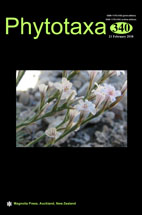Abstract
The tribe Spongoclonieae (Ceramiaceae subfam. Spongoclonioideae) is represented on the Atlantic and Pacific coasts of Mexico by two genera: Pleonosporium with eight species and Spongoclonium with a single species. Pleonosporium boergesenii and P. borreri are both new records for Atlantic Mexico. Known in Pacific and Atlantic Mexico, P. rhizoideum has the widest distribution, while P. pygmaeum and P. vancouverianum have only a few records in the study area. Pleonosporium mexicanum is found mainly in tropical Pacific Mexico, and P. globuliferum has a discontinuous distribution in the Gulf of California and then in Salina Cruz, Oaxaca. In the case of P. squarrulosum morphological and genetic comparisons are needed to verify its presence in Mexico. The report of Spongoclonium caribaeum from intertidal Veracruz (Gulf of Mexico) represents the second record of this species for the Atlantic coast of Mexico. Detailed descriptions, information on nomenclature, collections studied, distribution and habitat are provided for each of the species. Measurements of vegetative characters and reproductive structures provide a consistent basis for identifying Atlantic and Pacific Mexican species of Pleonosporium and Spongoclonium.

